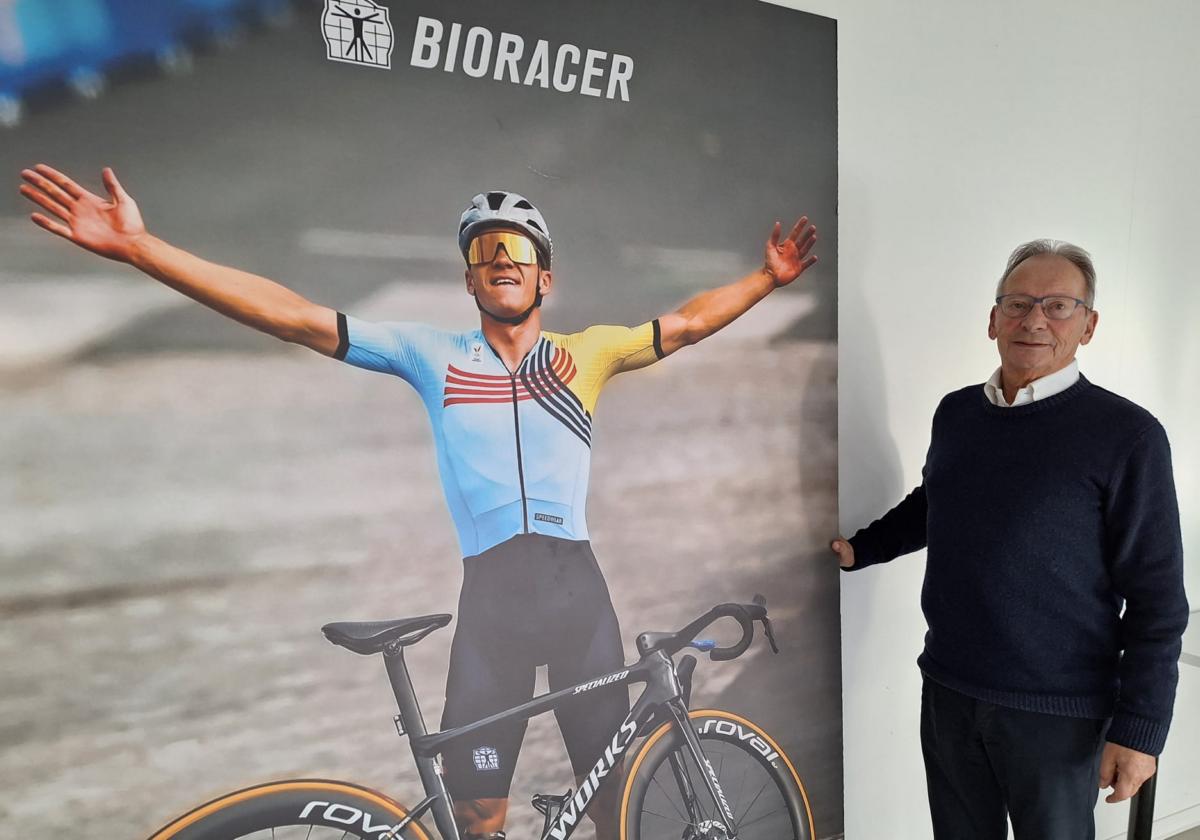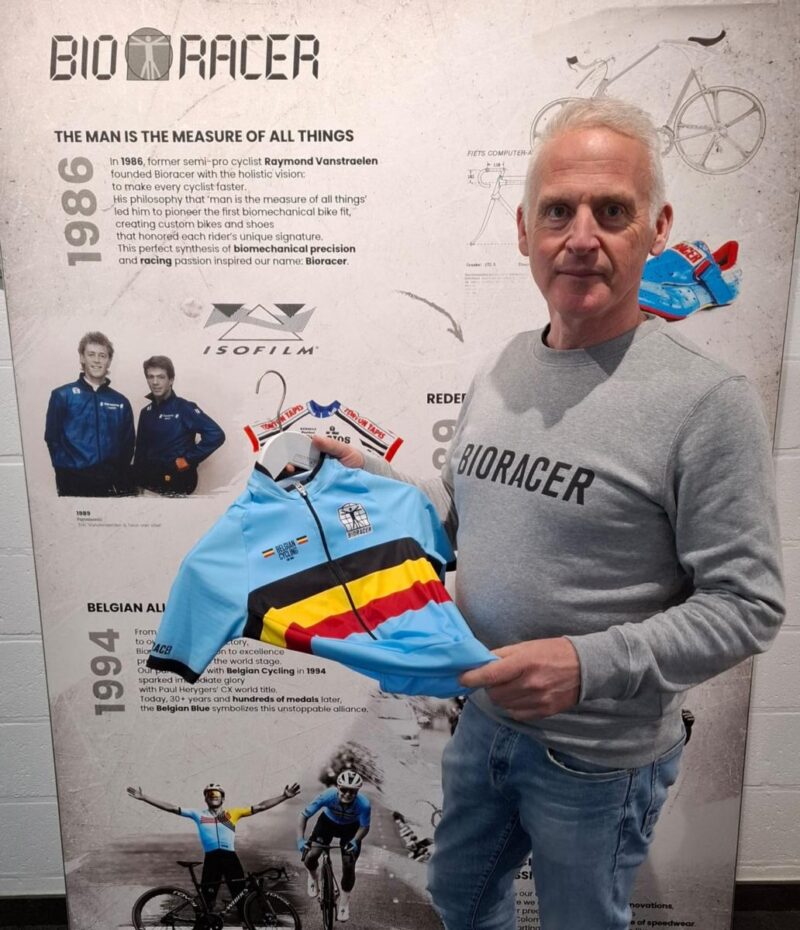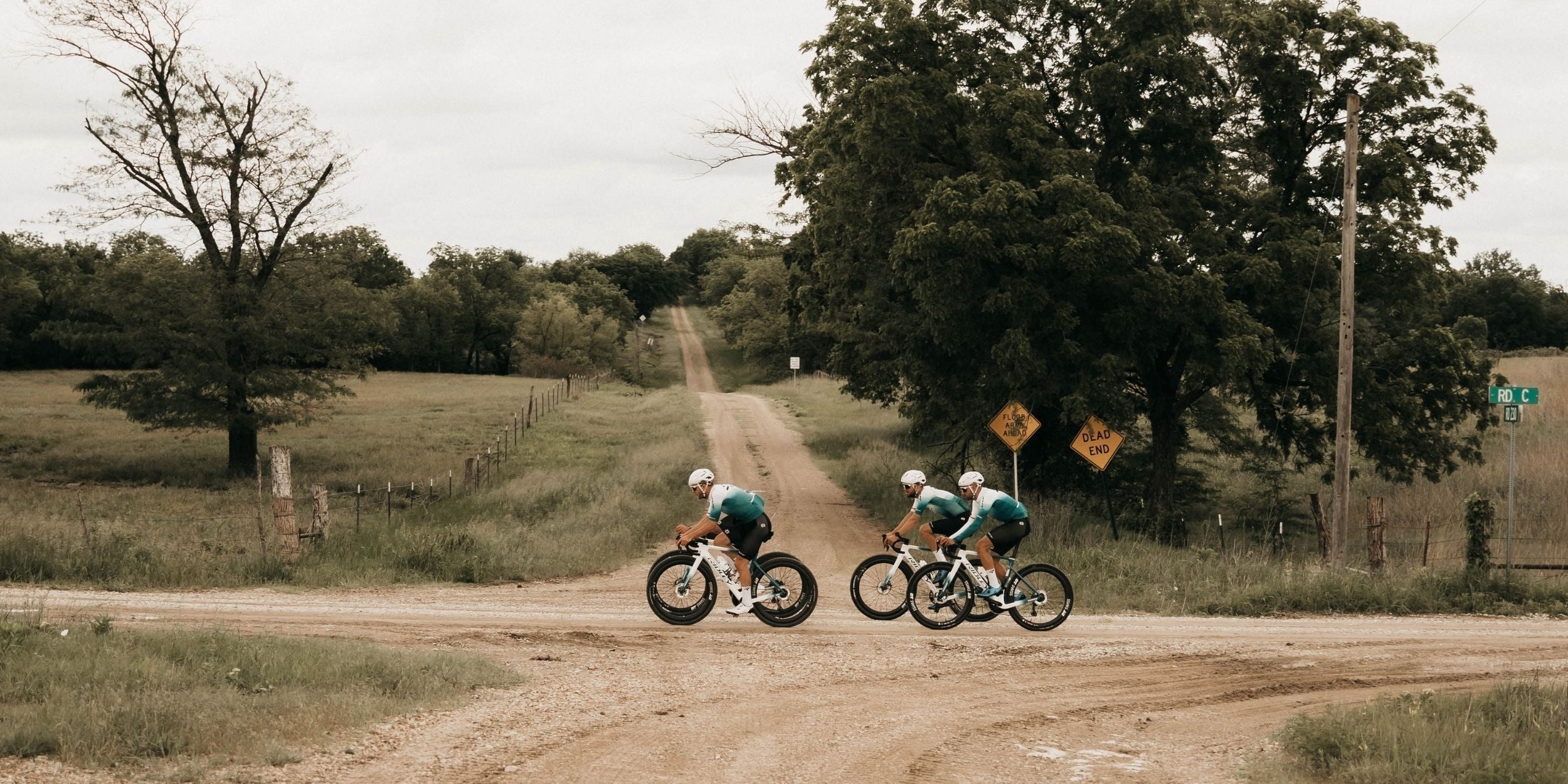Bioracer proudly stands as a name that resonates throughout the cycling world. In 1986, Raymond Vanstraelen founded the company with a crystal-clear mission: measuring and studying athletes in motion to optimize cycling performance. Our company has evolved into Europe's market leader in cycling apparel, generating an annual turnover of approximately 36 million euros. Raymond has passed the torch to our current CEO Danny Segers, but he still frequents our facilities and loves nothing more than sharing his insights on our operations. We presented him with several questions.
How did you originally start Bioracer, Raymond?
Raymond: "I was a cyclist myself until age 29. Even then, I was deeply fascinated by all the innovations gradually finding their way into cycling: new training methods, evolving bikes and components, and performance-oriented apparel. After my cycling career, I became a trainer at BLOSO. I was one of the first A-trainers and the only one specializing in cycling. I established the country's first 'cycling school' and mentored future champions like Eric Vanderaerden, Guy Nulens, Johan Capiot, and René Martens."
"In those days, bikes primarily came from Italy – think Colnago, Gios Torino, and Guerciotti. They manufactured standard frames according to typical Italian rider builds with steep angles. A tall rider received the same bike, just with tubes a few centimeters larger. Northern European riders often had different physiologies and needed bikes with different geometry. That's why I started Bioracer in 1986: 'Biomechanics for racers.'"
How do you reflect on that initial phase?
Raymond: "We began by measuring riders to build personalized frames, accurate to the millimeter. Jochim Aerts was our painter – he would later establish his own bike company that grew into what became Ridley. We still maintain an excellent relationship. But there was more. I was also frustrated with the racing shoes of that era. We created a new design that positioned feet to optimize power transfer. At one point, half the peloton was racing with our shoes – until my distributor went bankrupt."
That event ushered in a new era, didn't it?
Raymond: "On to new optimization opportunities, indeed! During that same period, I contemplated how cyclists' sportswear could be improved. Cycling jerseys were primarily made from wool and/or cotton. After a race, they weighed 3 kilos more than at the start. I knew that in skiing, they thoughtfully considered how apparel could be more aerodynamic and faster. So I traveled to Switzerland to partner with a ski apparel manufacturer. They produced garments in polyester and performance fabrics."
"The fabric supplier discontinued operations but convinced me to begin production myself. That was in 1987 or 1988, I believe. I was still working at RTT, as was my wife, who was trained as a clothing designer. You could take career breaks for the first time then. Plus, you received half your salary if you started your own business as an independent contractor. This way, we knew we'd maintain at least one income between us."
Which decisions proved to be game-changers?
Raymond: "We invested in 2 machines and began producing cycling jerseys in our garage. In subsequent years, we introduced numerous innovations: not only did we create aerodynamic, breathable cycling jerseys, but also rain jackets in Isofilm – something never before manufactured. Because I knew Vanderaerden and Nulens, their Panasonic team director Peter Post visited to place orders. Panasonic was the top team then, and that launched us. All major teams quickly came to us. We continued innovating. We created rider replicas using mannequins – the first was Tony Martin in 2009. Everyone's starting to do this now, but we've been doing it for 15 years. That gives Bioracer an incredible advantage."
"Bioracer's success is certainly attributable to the continuous innovations we bring to the cycling world. We were the first to test apparel in wind tunnels. Consider our national team's time trial suits at the Olympics that delivered Remco's gold and Wout's bronze. It's proven they had the fastest suits. This isn't just about aerodynamics but also body correction in precise locations so you can breathe properly. Equally important: cooling! Such powerful engines produce substantial heat, and just like a car's combustion engine, that motor must be efficiently cooled."
What role do you attribute to the Protolab?
Raymond: "In our Protolab, we develop apparel and test its ability to combat cold and regulate heat. We analyze cyclists in motion to ensure fabric, design, and construction provide anatomical fit with optimal comfort. We monitor wind tunnel data and real races to discover new ways to cheat the wind. But we equally learn from climbs, mud, crosswinds, cobblestones, and every meter of cycling from start line to finish."
The competition is fierce...
Raymond: "Absolutely brutal! And there are increasingly more competitors. Both in 'custom made' – designs on demand and tailored for cycling clubs – and in 'collections,' where we offer our own designs. But we maintain our leading position with even slight growth. This while the entire cycling sector is in crisis. It's a daily struggle to remain the best. Fortunately, we have a team of people passionate about cycling and the products we create. We produce approximately 15,000 new designs annually. Imagine that!"
Production has now definitively left Belgium, Raymond!
Raymond: "Production continued partially in Belgium until 2024, but the wage disadvantage became too significant. It was no longer responsible to continue manufacturing our products here. Moreover, you find few people here with textile education or sector experience. In recent years, we worked primarily with foreign seamstresses, even here in Limburg. That says enough. Only prototypes – new models – are still assembled here. We moved the remaining production entirely to Romania, Macedonia, Tunisia, and Colombia."
Countries with lower wages but also more technically educated workers...
Raymond: "The South American market is relatively new but important: partly because quality there is extremely high – comparable to Italy – but also because there's substantial local sales. We generate 3 million in turnover there. Our people also receive additional internal training. Prototypes in our international facilities must be executed perfectly. That means testing, checking, correcting, and testing again until it fits literally and figuratively."
Finally, a closing thought, Raymond. You have an interesting tattoo!
Raymond: "My granddaughter wanted me to get a tattoo for my 75th birthday. (laughs) I resisted somewhat, but she kept insisting. I agreed, with the condition that she get the same tattoo. When her birthday came later, we had 'serendipity' immortalized in ink on our skin. You must always think forward in life, never backward. I think 5 or 10 years ahead, even though I probably won't be walking these floors in 10 years. That's my 'serendipity' – the art of finding something valuable you weren't searching for. We haven't won multiple innovation awards for nothing. But maintaining that advantage is crucial, given growing competition. It's a daily battle."




Leave a comment
This site is protected by hCaptcha and the hCaptcha Privacy Policy and Terms of Service apply.